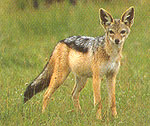BLACK-BACKED JACKAL

How to Recognize
Black-backed jackals are common to see. They have long legs, a pointed muzzle, non-retractile claws, and are the size of a small dog. They have a keen sense of smell, vision, and hearing. There are three types – golden jackal, side-striped jackal, or black-backed or silver-backed jackal (we only saw the black-backed jackal).
Habitat
Black-backed jackals have a broad habitat range from moist mountain regions to desert. Drier areas are preferred.
Behavior
They are normally nocturnal but become diurnal in the safety of game reserves. Jackals form monogamous pairs that breed, hunt, and scavenge together. The young may stay with their parents to help raise the new pups. They defend a territory by marking it with scents, urine, and howling choruses.
Breeding
All young are born underground in dens and receive intense parental care. The mother changes den sites about every two weeks so that the young are less likely to be found by predators. As they develop, pups become lively and playful.
Feeding
Jackals are bold scavengers getting their food from kills of larger predators (even lions!). They are also efficient hunters, cooperatively hunting small or young antelope such as dik diks, Thomson's gazelles, or even domestic sheep. They also eat snakes and other reptiles, insects, ground-dwelling birds, fruits, berries, and grass.
Enemies
Hyenas, eagles (who eat small pups), and leopards are a jackal's enemies. A jackal's defense is its speed, teeth, and erectile fur on its back and tail which makes it appear to have an enlarged profile.
TOP OF PAGE
Copyright © 2002, Dawn M. Dalton.
All rights reserved.
**LINKS**
WHERE?
WHY?
ITINERARY
PLAN YOUR TRIP
GETTING THERE
LONDON
KENYA
UGANDA
SAFETY
ITEMS BOUGHT
STAYING HEALTHY
COMMENTS
HOME
BHS HOME
---Animal Facts--
Baboon
Buffalo
Cheetah
Chimpanzee
Crocodile
Eland
Elephant
Gazelle
Giant Forest Hog
Giraffe
Gorilla
Hippopotamus
Hyena
Hyrax
Impala
Jackal
Lion
Mongoose
Monkey
Ostrich
Rhinoceros
Topi
Uganda Kob
Warthog
Waterbuck
Wildebeest
Zebra